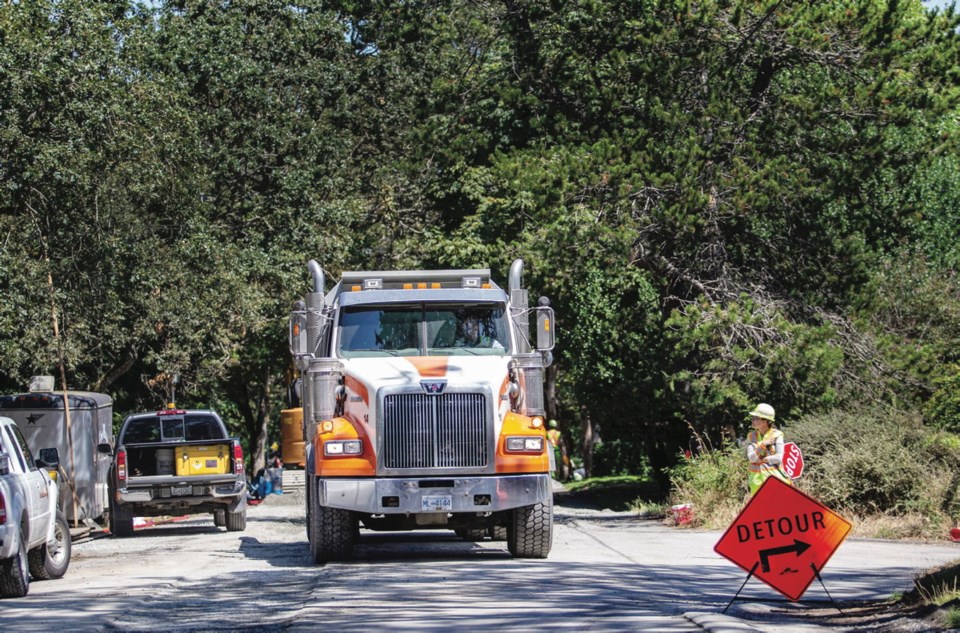“ ‘Residual solids conveyance line.’ I think that might be my new, favourite term,” Nature Boy announced.
“It sounds so clean and friendly. “Oh, hey, we’re conveying this stuff, just graciously passing it along, neighbour to neighbour, like a message along the bush telegraph. And the solids? They’re residuals. … mere nuthin’s.’ ”
He turned and gave me The Look. “But think about what it really means. …”
We had just run the early-morning gauntlet on Grange Road in Saanich. At 8:30 p.m., the construction crews had left for the day. The excavators, hydraulic breakers, compactors and other machinery were parked. The street up and down the hill was unimpeded but for a bumpy patchwork of original road surface, below-grade temporary asphalt, gravel-filled trenches and steel plates left by the construction in progress.
Since early June, crews have been installing the residual solids conveyance line along Grange as part of the CRD’s wastewater treatment project. When finished, the system will carry waste the 19 kilometres from the main treatment plant being built at McLoughlin Point to the residuals treatment facility being built at the Hartland dump.
But let’s dispense with the sanitized sanitation terminology and call it what it is. It’s a poo pipeline, an excrement expressway, a dung duct … or if you want to get fancy (-poo) pants, an underground egesta ejectamentary canal.
The Hartland facility will treat and transform the conveyed poo into class A biosolids — another sanitized phrase for something not very appetizing. Class A biosolids are sewage sludge drained and cooked according to official guidelines and approved for use as fertilizer.
The pipeline forms just one part of the wastewater-transport system. The other parts include the network of pipes that collect and move raw, just-flushed or drained wastewater from across the region’s core area to the McLoughlin Point plant, and the lines that carry the water drained from those class A biosolids-to-be back to McLoughlin Point.
Other segments of the pipeline are already finished. Installation along Bodega Road and Ker Avenue, for example, went quickly. Completion of the Grange Road section, however, has been delayed.
In December, neighbourhood residents rallied against the CRD’s pipeline plan for Grange. The proposed plan would have required the removal of up to 50 of the street’s mature Garry oak and Douglas-fir trees.
After protests, tours with members of Saanich council, media coverage and a petition, the CRD moved its plans for the line to the other side of the road. This saves most of the trees, but has meant construction is taking longer and disrupting the neighbourhood and traffic more.
Actually, it is taking longer even than those first, reassessed estimates. Bedrock sits immediately beneath parts of the road’s surface. And because a gas line runs down the same side of the road, blasting would endanger not just trees, but much of the neighbourhood. Instead, the crews have to resort to hydraulic breakers — giant jackhammers — to chip away the rock.
It is important to note that residents weren’t refusing to be on the refuse route. Nobody was holding out for compensation. They were campaigning to keep the canopy that transforms Grange Road into a rare and shady tunnel of green in the summer.
The pipeline has to go somewhere, after all. Although other nearby north-south streets are wider and have fewer trees, CRD engineers wanted to take advantage of Grange’s long, steep slope down to Interurban Road. They designed the pipeline to use that elevation drop — and gravity’s resulting effect — to push the pipeline’s future contents along, hurrying them on their way to the new Hartland facility and eliminating the need for more pumps.
In other words, Grange Road will serve as the pipeline’s feces flume. If you prefer assonance, you can call it a poop chute. You can even call it a crap shute. But whatever poo-phemism you use, don’t call it a crap shoot — the reference to gambling and high-stakes risk could make some folk squeamish.
Because a right stink would result if this pipeline were to spring a leak, so to speak, or become bunged-up with bolus or constipated with caca. And after the decade of debate about, loads of verbal floaties floated around and delays to the project, nobody is in a hurry to worry further about slurry.
Just like nobody likes to call it what it really is.



